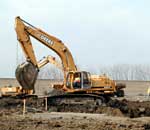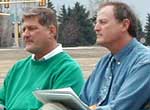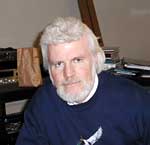By Dan Gunderson
Minnesota Public Radio
April 18, 2002
It's been five years since the Red River flowed over and through the dikes in Grand Forks and East Grand Forks. The water sparked a fire that destroyed much of downtown Grand Forks. The flood forced 55,000 people from their homes. Damage was estimated at nearly $2 billion. For residents, many painful memories remain. But signs of recovery are everywhere. Local leaders say Grand Forks and East Grand Forks are back, stronger than ever.
| |
|
|
|
||
Five years ago the rumble of heavy equipment marked the frantic but futile effort to contain the Red River. Today the roar of earthmovers is a sign of recovery and growth.
Hundreds of millions of dollars in construction projects have been completed in the past four years.
This week Grand Forks Mayor Mike Brown joined other dignitaries at a groundbreaking ceremony for a new Hilton hotel.
"I think we've made tremendous strides," said Mayor Brown. "People are still hurting from having to take out loans. Personal recovery is still going on. I think our business community is looking forward and moving forward and this is an example of that."
Mayor Brown sees reason to celebrate the progress five years after the flood, but many residents don't want to dredge up the painful memories.
"And they're choosing not to look back. I've gotten a lot of complaints, we want to have an unveiling this week on remembering the five year flood, and people don't want to do that," said the mayor. "They want to look forward. They don't want to dwell on the past. But I think it's important we recognize that event because it did draw us together as a community."
Grand Forks points with pride to its new Alerus events center, and the Ralph Englestad Arena. Across the river in East Grand Forks a state park and greenway are planned in now vacant neighborhoods along the river.
| |
|
|
|
||
There are also many new businesses which have created hundreds of jobs in the past four years.
Regional Economic Development Corporation President Mark Krauseneck said recovery would not have been possible without government help. The next step he says is promoting business and manufacturing growth.
"That's all private sector driven and it's a ratification of what's been done in the five years since the flood. It's a committment to this as a competitive viable location for people to do business and live," said Krauseneck.
In Grand Forks much of the focus has been on building a diversified economy and creating jobs.
Across the Red River in East Grand Forks, the emphasis has been on building a community where people will want to live.
About 5,000 people moved away from the devastated communities after the flood. Five years later the population is still below pre-flood levels.
Gary Emerson recalls several businesses that did not survive the flood. The building housing his East Grand Forks electronics business went under. He's now relocated the business a safe distance from the river.
Emerson point out that nearly everyone in Grand Forks and East Grand Forks still carries a heavy debt load as a result of rebuilding homes or businesses.
There's also anxiety as people wait for a $400 million dike system to be completed in 2006.
"We don't have flood protection right now. And it's about time we have flood protection," said Emerson. "I mean, it's been five years, where's the dikes. That gets to be nerve wracking, especially when the water comes up. It got scary last spring."
| |
|
|
|
||
Still, Gary Emerson is optimistic. He expects East Grand Forks to grow. After all the city has new streets and sewers, new schools and new public buildings. And they're all paid for.
"You put all those buildings and say this is what we've got in East Grand Forks, and you're not being taxed for it. That's pretty nice. That's going to encourage people to move back here because our tax base is low," said Emerson.
East Grand Forks Mayor Lynn Stauss said a critical first step in the recovery was rebuilding civic pride. He thinks a new city hall, a new library and four new schools give people hope for the future.
"I think it makes people believe we're for real. You know right after the flood they thought East Grand Forks would just dry up and die," said Mayor Stauss. "I think people, by seeing we're putting up good buildings that are going to be there for a long time, they can take pride in that and we can build from that."
Stauss is convinced his city could be the poster child for disaster recovery. He's proud of what's been accomplished with hundreds of millions of dollars in government aid. The challenge of the next five years, said Stauss, will be to ensure the rebuilt communities continue to grow and prosper.
More from MPRMore Information



